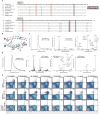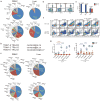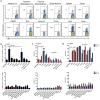MR1-restricted mucosal-associated invariant T (MAIT) cells respond to mycobacterial vaccination and infection in nonhuman primates
- PMID: 27759023
- PMCID: PMC5397382
- DOI: 10.1038/mi.2016.91
MR1-restricted mucosal-associated invariant T (MAIT) cells respond to mycobacterial vaccination and infection in nonhuman primates
Abstract
Studies on mucosal-associated invariant T cells (MAITs) in nonhuman primates (NHP), a physiologically relevant model of human immunity, are handicapped due to a lack of macaque MAIT-specific reagents. Here we show that while MR1 ligand-contact residues are conserved between human and multiple NHP species, three T-cell receptor contact-residue mutations in NHP MR1 diminish binding of human MR1 tetramers to macaque MAITs. Construction of naturally loaded macaque MR1 tetramers facilitated identification and characterization of macaque MR1-binding ligands and MAITs, both of which mirrored their human counterparts. Using the macaque MR1 tetramer we show that NHP MAITs activated in vivo in response to both Bacillus Calmette-Guerin vaccination and Mycobacterium tuberculosis infection. These results demonstrate that NHP and human MR1 and MAITs function analogously, and establish a preclinical animal model to test MAIT-targeted vaccines and therapeutics for human infectious and autoimmune disease.
Figures




References
Publication types
MeSH terms
Substances
Grants and funding
LinkOut - more resources
Full Text Sources
Other Literature Sources
Medical

